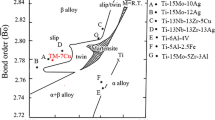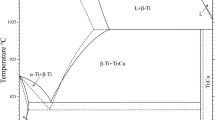Abstract
In this work, a process of cold rolling with 70% thickness reduction and different annealing temperatures was selected to regulate the microstructure of Ti-3wt%Cu alloy. Microstructural evolution, mechanical properties and antibacterial properties of the Ti-3wt%Cu alloy under different conditions were systematically investigated in terms of X-ray diffraction (XRD), scanning electron microscope (SEM), transmission electron microscope (TEM), tensile and antibacterial test. The results indicated that cold rolling could dramatically increase the ultimate tensile stress (UTS) from 520 to 928 MPa, but reduce the fracture strain from 15.3% to 3.8%. With the annealing temperature increasing from 400 to 800 °C for 1 h, the UTS decreased from 744 to 506 MPa and the fracture strain increased from12.7% to 24.4%. Moreover, the antibacterial properties of the Ti-3wt%Cu alloy under different conditions showed excellent antibacterial rate (> 96.69%). The results also indicated that the excellent combination of strength and ductility of the Ti-3wt%Cu alloy with cold rolling and following annealing could be achieved in a trade-off by tuning the size and distribution of Ti2Cu phase, which could increase the applicability of the alloy in clinical practice. More importantly, the antibacterial properties maintained a good stability for the Ti-3wt%Cu alloy under different conditions. The excellent combination of mechanical properties and antibacterial properties could make the Ti-3wt%Cu alloy a good candidate for long-term orthopaedic implant application.
Graphical abstract

摘要
本文采用70%冷轧工艺和不同的退火温度对Ti-3wt%Cu合金的显微组织进行了调控。采用X射线衍射 (XRD)、扫描电镜 (SEM) 、透射电镜(TEM )、拉伸试验和抗菌试验, 系统地研究了Ti-3wt%Cu合金在不同条件下的组织演变、力学性能和抗菌性能。结果表明, 冷轧可使抗拉强度由520 MPa显著提高到928 MPa , 但断裂应变由15.3%降低到3.8%。随着退火温度从400 ℃提高到800 ℃, 材料的抗拉强度从744 MPa下降到506 MPa, 断裂应变从12.7%上升到24.4%。此外, Ti-3wt%Cu合金在不同条件下的抗菌性能表现出优异的抗菌 率 (>96.69% )。通过调整Ti2Cu相的尺寸和分布,可以在冷轧和退火后获得强度和塑性的良好结合, 从而提高该合金在临床上的适用性。更重要的是, 在不同条件下,Ti-3wt%Cu合金的抗菌性能保持了良好的稳定性。Ti-3wt%Cu合金具有良好的力学性能和抗菌性能, 是一种长期应用于骨科种植体的理想材料。









Similar content being viewed by others
References
Kurtz S, Ong K, Lau E, Mowat F, Halpern M. Projections of primary and revision hip and knee arthroplasty in the United States from 2005 to 2030. J Bone Joint Surg. 2007;89(4):780.
Kapadia BH, Berg RA, Daley JA, Fritz J, Bhave A, Mont MA. Periprosthetic joint infection. Lancet. 2016;387:386.
Peel TN, Buising KL, Choong PF. Prosthetic joint infection: challenges of diagnosis and treatment. Anz J Surg. 2011;81(1–2):32.
Hostetler CE, Kincaid RL, Mirando MA. The role of essential trace elements in embryonic and fetal development in livestock. Vet J. 2003;166(2):125.
Burghardt I, Lüthen F, Prinz C, Kreikemeyer B, Zietz C, Neumann BG, Rychly J. A dual function of copper in designing regenerative implants. Biomaterials. 2015;44:36.
Sun D, Xu DK, Yang CG, Chen J, Shahzad MB, Sun ZQ, Zhao JL, Gu TY, Yang K, Wang GX. Inhibition of Staphylococcus aureus biofilm by a copper-bearing 317L-Cu stainless steel and its corrosion resistance. Mater Sci Eng C. 2016;69:744.
Vimbela G, Ngo SM, Fraze C, Yang L, Stout DA. Antibacterial properties and toxicity from metallic nanomaterials. Int J Nanomed. 2017;12:3941.
Zhuang YF, Zhang SY, Yang K, Ren L, Dai KR. Antibacterial activity of copper-bearing 316L stainless steel for the prevention of implant-related infection. J Biomed Mater Res B. 2019;108(2):484.
Ren L, Yang K, Guo L, Chai HW. Preliminary study of anti-infective function of a copper-bearing stainless steel. Mater Sci Eng C. 2012;32(5):1204.
Nan L, Liu YQ, Lü MQ, Yang K. Study on antibacterial mechanism of copper-bearing austenitic antibacterial stainless steel by atomic force microscopy. J Mater Sci Mater Med. 2008;19(9):3057.
Ng HP, Nandwana P, Devaraj A, Semblanet M, Nag S, Nakashima PNH, Meher S, Bettles CJ, Gibson MA, Fraser HL, Muddle BC, Banerjee R. Conjugated precipitation of twin-related α and Ti2Cu phases in a Ti-25V-3Cu alloy. Acta Mater. 2015;84:457.
Zhuang YF, Ren L, Zhang SY, Wei X, Yang K, Dai KR. Antibacterial effect of a copper-containing titanium alloy against implant-associated infection induced by methicillin-resistant Staphylococcus aureus. Acta Biomater. 2021;119:472.
Bao MM, Liu Y, Wang XY, Yang L, Li SY, Ren J, Qin GW, Zhang EL. Optimization of mechanical properties, biocorrosion properties and antibacterial properties of wrought Ti-3Cu alloy by heat treatment. Bioact Mater. 2018;3(1):28.
Kikuchi M, Takada Y, Kiyosue S, Yoda M, Woldu M, Cai Z, Okuno O, Okabe T. Mechanical properties and microstructures of cast Ti-Cu alloys. Dent Mater. 2003;19(3):174.
Cremasco A, Messias AD, Esposito AR, Duek EADR, Caram R. Effects of alloying elements on the cytotoxic response of titanium alloys. Mater Sci Eng C. 2011;31(5):833.
Wang XY, Dong H, Liu J, Qin GW, Chen DF, Zhang EL. In vivo antibacterial property of Ti-Cu sintered alloy implant. Mater Sci Eng C. 2019;100:38.
Zhang EL, Ren J, Li SY, Yang L, Qin GW. Optimization of mechanical properties, biocorrosion properties and antibacterial properties of as-cast Ti-Cu alloys. Biomed Mater. 2016;11(6):65001.
Fowler L, Janson O, Engqvist H, Norgren S, Öhman-Mägi C. Antibacterial investigation of titanium-copper alloys using luminescent Staphylococcus epidermidis in a direct contact test. Mater Sci Eng C. 2018;97:707.
Osório WR, Cremasco A, Andrade PN, Garcia A, Caram R. Electrochemical behavior of centrifuged cast and heat treated Ti-Cu alloys for medicalapplications. Electrochim Acta. 2010;55(3):759.
Zhang EL, Fu S, Wang RX, Li HX, Liu Y, Ma ZQ, Liu GK, Zhu CS, Qin GW, Chen DF. Role of Cu element in biomedical metal alloy design. Rare Met. 2019;38(6):476.
Shirai T, Tsuchiya H, Shimizu T, Ohtani K, Zen Y, Tomita K. Prevention of pin tract infection with titanium-copper alloys. J Biomed Mater Res Part B Appl Biomater. 2009;91B(1):373.
Zhang EL, Li FB, Wang HY, Liu J, Wang CM, Li MQ, Yang K. A new antibacterial titanium-copper sintered alloy: preparation and antibacterial property. Mater Sci Eng C. 2013;33(7):4280.
Peng C, Zhang SY, Sun ZQ, Ren L, Yang K. Effect of annealing temperature on mechanical and antibacterial properties of Cu-bearing titanium alloy and its preliminary study of antibacterial mechanism. Mater Sci Eng C. 2018;93:495.
Zhang EL, Wang XY, Chen M, Hou B. Effect of the existing form of Cu element on the mechanical properties, bio-corrosion and antibacterial properties of Ti-Cu alloys for biomedical application. Mater Sci Eng C. 2016;69:1210.
Bhaskaran TA, Krishnan RV, Ranganathan S. On the decomposition of β phase in some rapidly quenched phase titanium-eutectoid alloys. Metall Mater Trans A. 1995;26(6):1367.
Sun QY, Zhu RH, Gu HC. Monotonic and cyclic behavior Ti-2.5Cu of alloy at room temperature (293K) and at 77K. Mater Lett. 2002;54(2-3):164.
Shao S, Wang J, Beyerlein IJ, Misra A. Glide dislocation nucleation from dislocation nodes at semi-coherent 1 1 1 Cu-Ni interfaces. Acta Mater. 2015;98:206.
Zhang ZM, Zheng GT, Li HX, Yang L, Wang XY, Qin GW, Zhang EL. Anti-bacterium influenced corrosion effect of antibacterial Ti-3Cu alloy in Staphylococcus aureus suspension for biomedical application. Mater Sci Eng C. 2019;94:376.
Fowler L, Masia N, Cornish LA, Chown LH, Engqvist H, Norgren S, Öhman-Mägi C. Development of antibacterial Ti-Cux alloys for dental applications: effects of ageing for alloys with up to 10 wt% Cu. Materials. 2019;12(23):4017.
Nan L, Yang K. Cu ions dissolution from Cu-bearing antibacterial stainless steel. J Mater Sci Technol. 2010;26(10):941.
Maharubin S, Hu YB, Sooriyaarachchi D, Cong WL, Tan GZ. Laser engineered net shaping of antimicrobial and biocompatible titanium-silver alloys. Mater Sci Eng C. 2019;105:110059.
Percival SL, Bowler PG, Russell D. Bacterial resistance to silver in wound care. J Hosp Infect. 2005;60(1):1.
Sobczyk-Guzenda A, Szymanski W, Jedrzejczak A, Batory D, Jakubowski W, Owczarek S. Bactericidal and photowetting effects of titanium dioxide coatings doped with iron and copper/fluorine deposited on stainless steel substrates. Surf Coat Technol. 2018;347:66.
Wang JW, Zhang SY, Sun ZQ, Wang H, Ren L, Yang K. Optimization of mechanical property, antibacterial property and corrosion resistance of Ti-Cu alloy for dental implant. J Mater Sci Technol. 2019;35(10):2336.
Ren L, Ma Z, Li M, Zhang Y, Liu W, Liao Z, Yang K. Antibacterial properties of Ti-6Al-4V-xCu alloys. J Mater Sci Technol. 2014;30(7):699.
Liu R, Tang YL, Zeng LL, Zhao Y, Ma Z, Sun ZQ, Xiang LB, Ren L, Yang K. In vitro and in vivo studies of anti-bacterial copper-bearing titanium alloy for dental application. Dent Mater. 2018;34(8):1112.
Wu JH, Chen KK, Chao CY, Chang YH, Du JK. Effect of Ti2Cu precipitation on antibacterial property of Ti-5Cu alloy. Mater Sci Eng C. 2020;108:110433.
Acknowledgements
This work was financially supported by the National Natural Science Foundation of China (Nos. 51404302 and 51801003) and the Natural Science Foundation of Hunan Province (No. 2020JJ4732).
Author information
Authors and Affiliations
Corresponding authors
Ethics declarations
Conflict of interests
The authors declare that they have no conflict of interest.
Rights and permissions
About this article
Cite this article
Yang, HL., Zhu, MZ., Wang, JY. et al. Optimization of mechanical and antibacterial properties of Ti-3wt%Cu alloy through cold rolling and annealing. Rare Met. 41, 610–620 (2022). https://doi.org/10.1007/s12598-021-01841-x
Received:
Revised:
Accepted:
Published:
Issue Date:
DOI: https://doi.org/10.1007/s12598-021-01841-x




